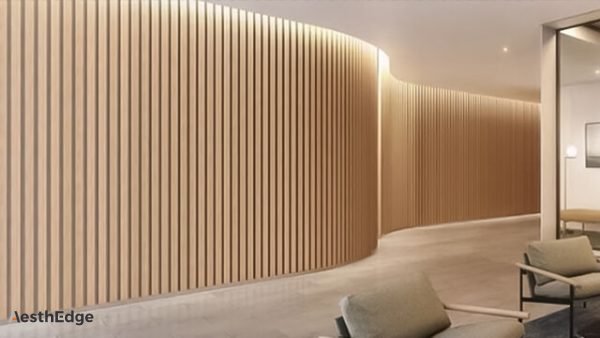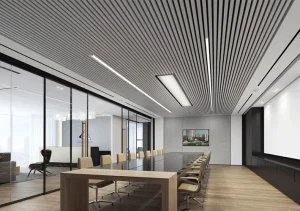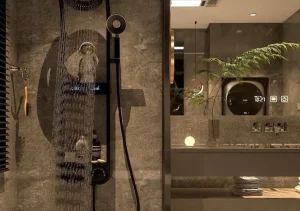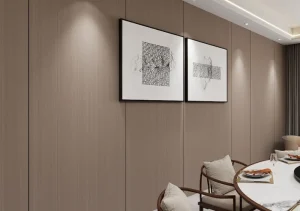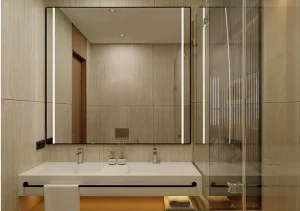When doing interior decoration, WPC wall panels (wood plastic composite materials) and solid wood wall panels are the two most popular choices. The two are only similar in appearance, but there are significant differences in their internal materials, performance, and usage scenarios. This article will help you make informed decisions about product selection by comparing their core factors such as materials, durability, environmental friendliness, and installation costs.
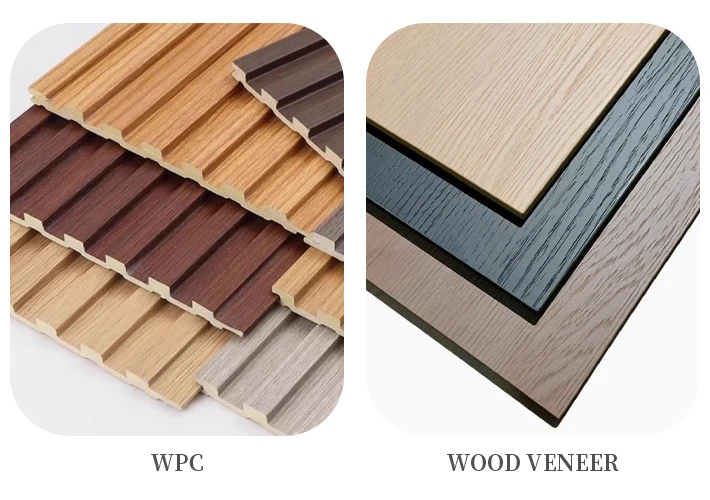
Table of Contents
ToggleWhat is WPC wall panel?
WPC (Wood Plastic Composite) is a new environmentally friendly material made by mixing wood fibers (wood powder or sawdust) with thermoplastic plastics (polyethylene, polypropylene, PVC) and additives. It combines the natural texture of wood with the durability, ease of maintenance, and antioxidant properties of plastic additives. Widely used in wall panels, flooring, and outdoor facilities.
Core features of WPC wall panels:
Composition ratio: Composed of 55% wood fiber, 35% thermoplastic, and 5% additives.
Surface treatment: The surface can imitate wood grain, stone grain, modern style or mirror style, and the texture is wirelessly connected.
Durability: Waterproof, moisture-proof, insect proof, suitable for humid environments and various complex climates.
Easy installation: Lightweight design, using card type links, simple installation operation, no need for professional installers.
Characteristics of traditional wooden wall panels
Wooden wall panels are processed from natural woods such as pine, rubberwood, and teak. Preserving the natural texture and touch of wood, as well as the woody aroma it possesses. But the disadvantages are also obvious, easily affected by the environment, requiring regular maintenance to prevent cracking, warping, etc.
The core characteristics of wooden wall panels are:
Pure natural wood: 100% cut from logs, but relying on forest resources requires extensive logging.
High maintenance requirements: If the moisture content of the wood is below 9%, cracking may occur, so regular painting, waxing, or sealing treatment is needed to prevent cracking.
Environmental limitations: It is prone to mold, rot, and deformation in humid environments. Avoid direct sunlight.
Installation complexity: Due to the straight cutting of logs, the weight is heavier than that of WPC wall panels, and professional installers are required for cutting and fixing during installation.
WPC wall panel vs. wooden wall panel: seven key differences
Material composition and environmental friendliness
WPC wall panel:Grinding wood chips or tree branches into powder can reduce resource waste. But some products have not undergone professional testing and contain inferior plastic that cannot be degraded. Choose our AesthEdge products, which have been tested by professional institutions and have CE and ISO certifications.
Wooden wall panels:Natural wood is renewable, but excessive logging may damage the environment and lead to ecological imbalance. Not conducive to the development of sustainable development strategies. Chemical anti-corrosion treatment may also pollute the environment.
Waterproof and weather resistance
WPC wall panels:WPC wall panels are completely waterproof and can be used in damp areas such as bathrooms, kitchens, balconies, etc. However, it is important to avoid soaking WPC wall panels directly with water.
Wooden wall panels:It has a high water absorption rate and may swell after washing. Prolonged accumulation of water may cause odor or decay. Only suitable for dry environments (living room, bedroom). Additional waterproof coating is required at the bottom of wooden wall panels.
Service life and maintenance cost
WPC wall panel:The service life can reach 25+years, and daily use only requires gently wiping with a damp cloth soaked in soapy water. If carefully maintained, the service life may be longer, up to 35 years.
Wooden wall panels:Proper maintenance can achieve a service life of 10-20 years, and regular maintenance is required 1-2 times a year to polish, paint, seal, and perform other operations on the wall panels. It is also necessary to regularly eliminate termites. Long term maintenance costs are higher.
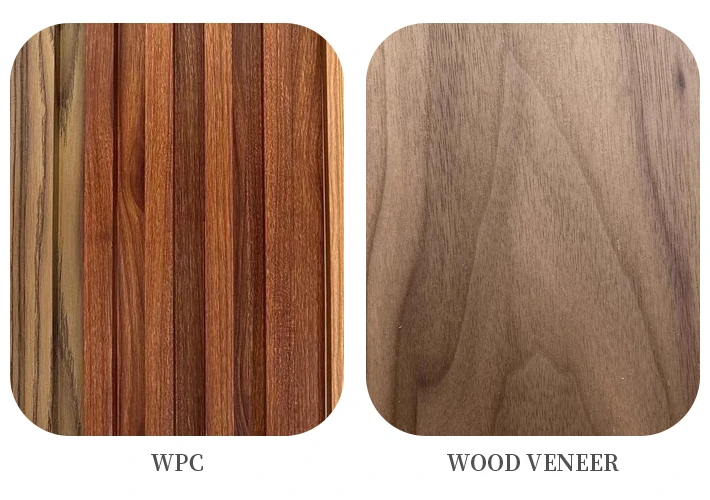
Appearance and design flexibility
Appearance and design flexibility
WPC wall panel:The surface texture is more uniform and can provide various textures such as wood grain and stone grain. We have over 10 color options for color selection. Can match various decoration styles.
Wooden wall panels:The texture of wood is unique, and in terms of decoration style, it is a high-end luxury design such as new Chinese style, medieval style, pastoral style, and retro style. However, each batch of products may have color differences, which affect the overall use effect.
Installation difficulty and cost
WPC wall panel:Lightweight and easy to install, simply apply glue to the back and secure with screws. You can also DIY install your own style to save labor costs.
Wooden wall panels:Professional cutting tools are required for cutting, which require screws to be fixed on the wall. This requires hiring a professional installation team, which is time-consuming and labor-intensive.
Price comparison
WPC wall panel:The starting price of WPC wall panels may be higher than that of ordinary wood wall panels, but in terms of long-term cost-effectiveness, the price of WPC wall panels is much lower than that of ordinary wood wall panels. Because in terms of maintenance and service life, WPC wall panels do not require labor for complex maintenance and only require simple wiping, and their service life is much longer than wooden wall panels.
Wooden wall panels:The price of low-end wood is very affordable, but long-term maintenance, painting, polishing, and other operations consume a lot of labor and time, making the cost-effectiveness relatively low. However, the initial cost of high-end wood is already very high, and the maintenance cost in the later stage will be even higher.
Applicable scenarios
WPC wall panel:The decoration design suitable for the finishing touch expenditure of family residences can be matched with modern minimalist style. It is also applied in commercial spaces such as hotels, restaurants, and other places.
Wooden wall panels:Suitable for dry indoor decoration, such as living room TV background walls, study rooms, etc. And high-end residences that pursue natural texture.
How to choose: WPC wall panel or wooden wall panel?
The two core advantages of wood plastic wall panels
The ultimate guardian of building materials
1.Revolutionary breakthrough in composite materials
WPC (Wood Plastic Composite) forms a natural moisture barrier by fusing high molecular weight polymers with wood fibers or wood powder. In actual testing, the water absorption rate is only 0.5%, which is only 1/20 of solid wood. After 1500 hours of testing in an environment with a continuous humidity of 80% in the laboratory, there was no deformation or warping of the wall panels.
2.Preventing termite erosion
Adding 5% additive to the substrate contains ant repellent, which forms a dual protective net of physical hardness isolation and chemical isolation. Through SGS certification testing, the prevention efficiency of termites and wood boring insects has reached 98%. Especially suitable for tropical and subtropical regions, rainy and humid areas.
3.Extreme climate adaptability
Our product can maintain stability within a temperature range of -40 degrees Celsius to 80 degrees Celsius. Especially suitable for areas with large temperature differences between day and night, severe cold, and extreme heat. Can maintain product stability for a long time.
Low cost maintenance solution
1.Easy to clean surface
By using UV weather resistant layer composite technology, a smooth surface similar to the lotus leaf effect can be formed. Daily maintenance only requires washing with soapy water and wiping with a cloth, saving 87% of maintenance costs annually compared to traditional wood.
2.Permanent protection system
By using the latest production technology, the sandwich structure protective layer formed by co extrusion can achieve better results. The UV resistance level can reach the ISO standard. The scratch resistance performance surpasses that of traditional wooden wall panels. Due to the addition of fixing agents, the color fidelity can reach over 15 years.
Two core advantages of wooden wall panels
Pursuing natural aesthetics
The warm touch and unique texture of solid wood are unique characteristics that cannot be completely replaced. This kind of warmth with life memory is something that industrial synthetic boards can never replicate. After being exposed to sunlight, the unique natural texture and woody aroma of wood can make a comfortable home even warmer. Even precision printing art cannot replicate the visual phenomenon of flatness.
Customized design
Wood wall panels can be carved, allowing you to experience the unique techniques of craftsmen and create a craft aesthetic that combines your aesthetic preferences. Adapting to the decoration style of your home will make the room more elegant. It can also be used for aging and meet personalized customization requirements.
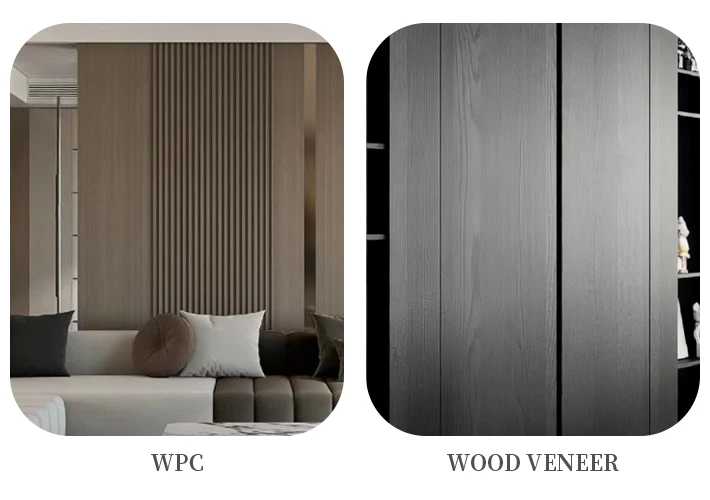
Mixed use solution: Balancing aesthetics and functionality
In the decoration design. WPC wall panels and wooden wall panels are not an either or choice. They can be cleverly mixed and matched to enhance the durability of WPC and increase the natural beauty of wood. At the same time, it can also reduce the overall cost budget.
The combination of humid and dry areas
1.Design points
Clear regional division:
Based on the overall layout of the space, humidity, frequency of use, and visual effects. Firstly, divide the wall into functional priority zones and aesthetic priority zones. For example:
Functional priority areas refer to areas that are frequently used and may have humidity, such as bathrooms, balconies, kitchens, etc.
Aesthetic priority zone refers to areas with low usage frequency and dry conditions, such as living room background walls, sofa background walls, bedroom headboard walls, etc.
Transition design:
At the junction of two materials, such as the connection between a bathroom and a hallway, a natural transition can be achieved through the following method:
Same color scheme matching: Choose WPC wall panels that are similar in color to the wooden wall panels, weaken the material differences, and achieve a perfect transition between the two.
Decorative line separation: Using metal lines, gypsum lines, or solid wood as connecting elements can cover seams and enhance layering.
2.Advantage analysis
Cost optimization: Only use high priced solid wood materials in necessary areas, and use WPC wall panels in other areas to reduce costs.
Extend lifespan: Protect damp areas from mold and deformation, and maintain stable wood in dry areas.
Unified style: By matching colors and textures, the overall space is made continuous, avoiding a sense of spatial fragmentation.
WPC wall panel and wooden wall panel decoration combination
1.Design techniques
Grassroots+decorative layer structure:
Grassroots: WPC wall panels are widely used as backgrounds, taking advantage of their high flatness, diverse styles, and resistance to deformation.
Decorative layer: Locally embed solid wood lines, carved boards, light strips, or 3D decorative elements on the surface of WPC to gather visual focus.
Common combination forms:
Wall panel+waistline: WPC wall panel covers the lower part of the wall, with solid wood carved waistline separating the top. The upper part is painted with latex paint or wallpaper.
Geometric splicing: Cut WPC wall panels into rectangular and hexagonal modules, embed wooden strips in the gaps, and create a modern artistic sense.
Frame decoration: Use dark solid wood strips to outline symmetrical frames on WPC wall panels, creating an American or classical atmosphere.
2.Style adaptation suggestions
Light luxury style:
Substrate: Matte pure white WPC wall panel.
Decoration: Champagne colored metal lines+thin brass carved panels.
Nordic natural wind:
Substrate: Light oak wood grain WPC wall panel
Decoration: Unpainted pine tree shaped three-dimensional patches.
New Chinese Style:
Substrate: Deep walnut wood grain WPC wall panel
Decoration: Hollow out solid wood carved board with herringbone pattern and metal waistline.
3.Construction techniques
Fixed method:
WPC wall panels are fixed with buckles or adhesive, but first ensure that the wall surface is flat.
It is recommended to use structural adhesive and invisible nails for double fixation of solid wood decorative parts to avoid detachment caused by thermal expansion and contraction.
Seam treatment:
Reserve 1-2mm expansion joint at the joint between WPC wall panel and wood wall panel, and fill it with elastic sealant.
Complex carved parts can be prefabricated in the factory and assembled directly on site to reduce cutting losses.
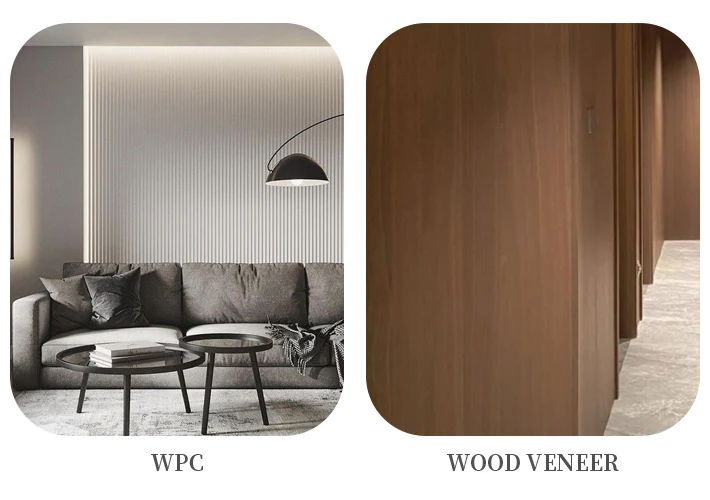
Future trend: Will WPC wall panels replace wooden wall panels?
With the tightening of global environmental policies, the response to global sustainable development strategies, and breakthroughs in material technology, the interior decoration materials industry is undergoing structural changes. WPC wall panels and wooden wall panels have not entered a situation of mutual substitution competition, but have opened up differentiated tracks based on their respective advantages, forming an industrial pattern of dual track parallel functionality and aesthetics.
Purchase suggestion: choose the suitable wall panel
Clearly define the usage scenario
Core logic: Determine the priority of using materials based on the environmental conditions of different regions
1.Classification of humidity levels
| Humidity range | Common areas | Recommended materials |
| High humidity (>70% RH) | Kitchen, basement | WPC wall panel (waterproof and mildew proof) |
| Moderate humidity (50-70%) | Window free balcony, laundry room | WPC or modified engineering wood |
| Low humidity (<50%) | Living room, bedroom, study | Natural wood/engineered wood |
2.Frequency of use evaluation
High frequency contact areas (such as children’s rooms and corridors): Choose WPC wall panels or bamboo wood composite panels with high surface hardness.
Low frequency viewing area (such as background decorative walls): Fine textured but low hardness wood (such as cherry wood) can be selected.
3.Special Requirements List
Near the fire source (such as around the fireplace)
→
choose materials with flame retardant treatment that meets the national standard B1 level.
Comparing Budgets – Accurately Calculating ‘Ten Year Holding Costs’
If you only focus on the unit price, you may suffer a big loss! We need to calculate the total cost of the entire product lifecycle.
Cost Calculation Template (Taking 10㎡Wall as an Example)
| project | WPC wall panel (middle end) | Solid wood wall panel (oak) |
| material cost | ¥3,500(¥350/㎡) | ¥8,000(¥800/㎡) |
| installation costs | ¥ 800 (snap on DIY) | ¥ 2000(requires woodworking cutting) |
| 10-year maintenance fee | ¥0 | ¥ 4000 (apply oil annually) |
| Residual value (second-hand transfer) | ¥ 500 (detachable and recyclable) | ¥ 1200 (premium for high-end wood) |
| Total cost for 10 years | ¥3,800 | ¥12,800 |
Conclusion
WPC wall panels and wooden wall panels each have their own advantages and characteristics, and the choice depends on your priority:
If pursuing products with zero maintenance and high cost-effectiveness, then WPC is the most ideal choice.
If you value natural texture and luxurious atmosphere, wooden wall panels are the best choice.
AesthEdge is a professional WPC wall panel manufacturer and trader with years of industry experience. We are located in Linyi City, Shandong Province. Contact us for free samples.

